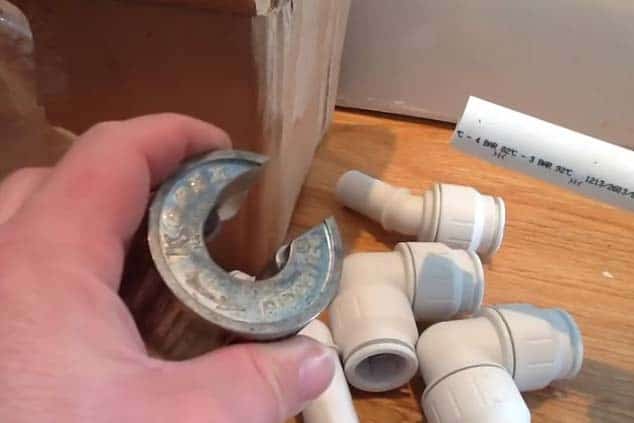When it comes to plumbing, a few primary materials are used. Copper, plastic, and galvanized steel are the three most common. You have come to the right place if you want to cut plastic pipe using a copper pipe cutter.
Can you cut the plastic pipe with a copper pipe cutter?
Yes, you can cut the plastic pipe with a copper pipe cutter. It depends on the type of plastic pipe and the copper pipe cutter. However, it is usually possible to cut the plastic pipe with a copper pipe cutter, although it may be more complex than cutting metal pipe. It is essential to take care when using a copper pipe cutter to avoid damaging the plastic pipe.
In this post, we’ll be discussing how to cut the plastic pipe with a copper pipe cutter.
What Are Plastic Pipes Made of?
Plastic pipes are commonly made from polyvinyl chloride (PVC), a type of plastic known for its durability and resistance to corrosion.
PVC pipes are also relatively lightweight and easy to install, making them popular for residential and commercial plumbing applications. Other plastics, such as polypropylene (PP) and polyethene (PE), are also used to make piping, but PVC is the most common.
There are many different plastic pipes, each with its own benefits and drawbacks. The most common plastic tubes are made from PVC, PE, and ABS.
PVC pipes are solid and durable but can be brittle in cold weather. They are also unsafe for drinking water, as PVC contains harmful chemicals.
PE pipes are flexible and resistant to chemicals and corrosion. They are often used for underground piping, as they will not rust or corrode. However, PE pipes can be challenging to connect and are not as strong as PVC pipes.
ABS pipes are strong and impact resistant. They are often used in plumbing and electrical applications to withstand high temperatures. However, ABS pipes can be difficult to weld and are not as flexible as PE pipes.
How to Cut the Plastic Pipe with The Copper Pipe Cutter?
A copper pipe cutter is designed to cut through a plastic pipe, and it is a relatively straightforward process. Here is how to use a copper pipe cutter to cut plastic pipe:
- To use the copper pipe cutter, you first need to measure the length of the cut you need to make.
- Locate the spot and score a line around the pipe where you will cut
- Place the copper pipe cutter over the tube so that the blade is touching the pipe.
- Squeeze the handles of the copper pipe cutter together to cut through the line.
- Release the handles of the copper pipe cutter and remove the cut piece of pipe.
FAQ:
Can you cut the plastic pipe with a hacksaw?
When cutting plastic pipe with a hacksaw, mark the area where you wish to make the cut. Then, position the hacksaw blade on the line and start sawing. As you see back, apply even pressure to the hacksaw blade to make sure it cuts through the pipe.
Can you cut CPVC with a copper pipe cutter?
Yes, you can use a copper pipe cutter to cut CPVC pipe. However, you will need to take extra steps to ensure the cut is clean and accurate.
First, make sure the blade of the copper pipe cutter is sharp. If it is not, sharpen it before using it to cut CPVC. Second, make sure the pipe is clamped securely in the pipe cutter. The tube may slip and cause a poor cut if it is not.
Finally, use a gentle back and forth motion when cutting the pipe. Do not use a lot of force, as this may cause the blade to slip and damage the line.
What tool do you use to cut PVC pipes?
A few different tools can be used to cut PVC pipes. A hacksaw can be used to cut PVC pipe, but it can be challenging to get a straight cut. A PVC cutter is a tool that can easily cut PVC pipes. It looks like a pair of scissors, and it has a blade specifically designed to cut PVC pipe.
Can you use a copper pipe cutter for PEX?
You can use a copper pipe cutter for PEX, but it is not the best tool for the job. A copper pipe cutter is designed to cut copper with a much harder metal than PEX. PEX is softer and can easily be cut with a sharp knife or scissors.
If you have a copper pipe cutter, you can use it to cut PEX, but it is likely to be more difficult than using a knife or scissors.
Is plastic pipe the same as PVC?
While PVC (polyvinyl chloride) and plastic pipes are both made from polyvinyl chloride, there can be a big difference in quality.
PVC is higher quality material and is less likely to leak or burst than plastic pipe. If you’re looking for a long-lasting and reliable plumbing solution, PVC is the way to go.
What’s the Difference Between Schedule 40 and Schedule 80 PVC?
If you’re in the market for PVC pipe, you may have noticed two different types: schedule 40 and schedule 80. But what’s the difference between the two?
PVC pipe is often classified by its schedule. Schedule 40 PVC is usually white in colour and has thinner walls than Schedule 80 PVC, generally dark grey and thicker walls. The wider the walls of the PVC pipe, the higher the pressure rating and the higher the price.
Schedule 40 PVC is the most common type of PVC pipe. It is usually used for drainage and lower pressure applications. Schedule 80 PVC is thicker-walled and is used for higher pressure applications.
Both Schedule 40 and Schedule 80 PVC pipes have the same outside diameter. The only difference is in the wall thickness. Schedule 40 PVC has thinner walls and is less expensive, while Schedule 80 PVC has thicker walls and is more expensive.
Schedule 40 PVC is strong enough for most home and business applications, while Schedule 80 PVC is often used in industrial or higher pressure applications.
Conclusion
Cutting the plastic pipe with a copper pipe cutter is possible but not recommended. The plastic tube is much more challenging to cut than copper pipe, and it is easy to damage the line or the cutter by using the wrong tool. A better option for cutting plastic pipes is to use a saw explicitly designed for the task.



